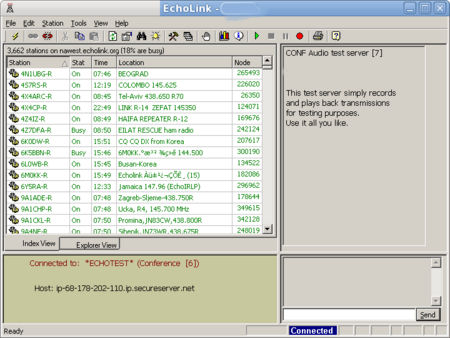Echolink: Difference between revisions
| Line 18: | Line 18: | ||
[[Image:VK4YEH_EchoLink.png|450px]] | [[Image:VK4YEH_EchoLink.png|450px]] | ||
The user selects a contact from the list and communication is carried out using the computer microphone. | |||
Revision as of 13:42, 10 May 2008
Related Wiki pages: IRLP, D-Star
Introduction
Echolink is a VOIP (Voice Over IP) application that allows amateurs to connect to one another using the internet. It is similar to IRLP, but allows users to connect via either radio or computer. Application versions are available for PC and Mac computers. Echolink is not usually described as a digital mode - although VOIP is digital transmission of voice - as most operators will use an FM radio to connect to the echolink network.
VOIP connections of any sort - including Echolink - require a DSL connection to the internet. A minimum connection speed of 256KBs is usually recommended for effective, clear VOIP applications.
Using Echolink on a computer
As Echolink is an uses internet protocols for transmission of voice, various ports must be open in your firewall for it to operate properly, the Echolink website summarising the requirements thus:
- Allow UDP destination ports 5198-5199 between Internet and PC in both directions
- Allow TCP (source port any, destination port 5200) from PC to Internet
Because the firewalls only allow port directs to particular IP addresses - and hence computers - Echolink can in most cases only be used on one computer at a time in a particular household. Some ISP's may allow multiple unique external IP addresses, in which case echolink can be used on multiple computers.
The Echolink application presents a window such as the one below to the user.
The user selects a contact from the list and communication is carried out using the computer microphone.
